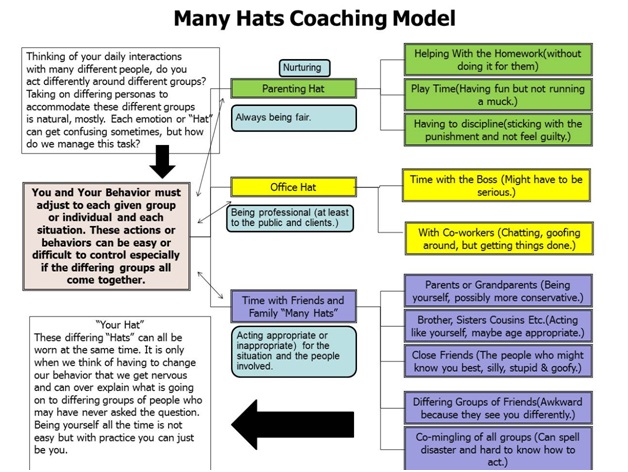A Coaching Model Created by Paul Kolibaba
(Executive Coach, UNITED STATES)
We all have different segments to our lives, in these segments we will encounter and interact with many different types of people. How we act around those different people, what we say and what words we use will differ greatly. Sometimes these different groups of people will overlap. I like to think of the differing ways we act as wearing different hats.
Home: No hat, being completely who we really are, maybe, see next example.
Parent: With parenting differing hats can happen rather quickly. Examples: the fun hat, the disciple hat, the caring (caregiving hat), helping the kids with their homework hat and the just being there for your kids hat. The list of parenting hats seems to never end and are often all worn at the same time.
Work: There is a work hat; business hat, things must still get done. When the boss is around you might have to be more serious, business hat. If you are lucky you might have a boss who is ok with acting a little goofy, great. Co-worker hat, people you can joke around with and make fun of, but still people you need to work with and get things done.
Family time: When it comes to Families the stacks of hats might get very tall. Your immediate family might get a few different hats. Mom and Dad might get one, brother or sister might get another. Jokes you can say in and around your family, inside jokes etc. The Grandparents hat, with Grandparents the hat might have you acting very well behaved or not, everybody is different, every family is different. There can be an enormous hat in the room with family that no one wears or wants to wear that is the hat filled with things no one talks about. The elephant in the room or in this example the elephant in the room wearing a big hat pulled tight around his ears to not let the secrets out.
Coaching Questions:
- How do you cope with wearing these different hats? Is the transition easy or is it difficult? Is it even necessary?
- Are you a person who is so comfortable with yourself that you don’t see the need to wearing differing hats? How does that work out for you?
- How did you come to realize that sometimes we have to act differently around differing people?
- Was the idea to act differently around say your Grandparents taught to us by our parents? Probably.
Most people “wear” many hats. What I mean is that people behave and act differently around different sets of people. The way people may talk or joke around with their friends is not the same way they might act around their boss or Grandparents, children (their own or someone else’s) etc.
It is often an uncomfortable time when your different groups met each other, how does someone handle those awkward situations? This is a time to wear your “Neutral” hat, the all-encompassing hat that people will hopefully understand what you mean or are trying to achieve. Peace and understanding between all groups involved in the event.
With all the many Hats: Work, friends, Parents, Grandparents, Co-workers, boyfriend or girlfriend or friends, family etc. Don’t forget the hat we wear when we are by ourselves. There is always one more hat, the most important hat of all.
The Values hat or the Morals hat, what do we value? When are our morals being tested?
Switching between hats is not a difficult thing or maybe it is, but most can do this automatically. Act one way at work or with friends or family etc. The lucky person is the one who doesn’t feel the need to act differently around combined groups
Coaching application: Helping the client to recognize the differences in the Hat(s) they must wear at any given time. The understanding that our Core Values don’t change because we are around different sets of people and that is a good thing. Also help the client to realize that everyone around them is also wearing many hats and to act accordingly.
It is my hope that the following graphic example will help explain what I mean. You can wear many hats all at the same time and still function.
